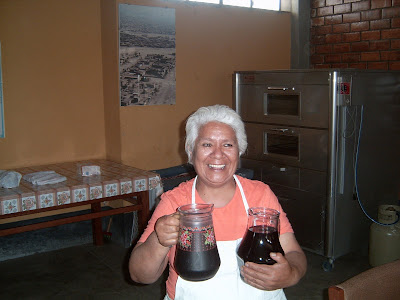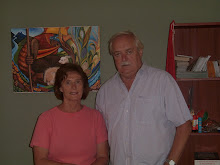
The table was set and ready to go for the Sunday meal.
Last Sunday we invited a group of young people to share lunch with us in our house. It was also an opportunity for the group to practise their English in a social setting. The three lay missionaries – Angelica, Jorge and Alfredo; four of our English students – Joao, Jeny, Martin and David; and a German girl who is working in the parish for a year – Anna. Unfortunately Jeny and Martin could not attend because of work commitments, however, Father Mick, Kate and Gerry were present.

The crowd gathers for lunch. From left to right we have Marion and Joao in deep conversation; Jorge clowning around for the camera; Alfredo, Anna, David partly hidden and Angelica make up the group.
Kate and Marion were the main chefs for the day – and very good ones at that! In fact Kate prepared and presented for all her renowned apple crumble and cream.


The meal is served and obviously Kate and Marion seem to be enjoying their efforts while Mick makes sure he has photographic proof of the day.
 The Yunza tree is a very important Peruvian festival celebrated during the month of February. It originated on their campesinos or farms. The people decorate the Yunza tree with gifts and then proceed to sing and dance around it while they take turns to try and chop it down and share all the gifts. The person who successfully lands the final chop is the organiser of the next year’s Yunza. Another much loved February activity is the throwing of water everywhere and on everyone! We learnt very quickly that when travelling on buses make sure your window is closed!
The Yunza tree is a very important Peruvian festival celebrated during the month of February. It originated on their campesinos or farms. The people decorate the Yunza tree with gifts and then proceed to sing and dance around it while they take turns to try and chop it down and share all the gifts. The person who successfully lands the final chop is the organiser of the next year’s Yunza. Another much loved February activity is the throwing of water everywhere and on everyone! We learnt very quickly that when travelling on buses make sure your window is closed! Pachamama, Mother Earth. The word Pachamama is Quechan and is derived from ‘mama’ mother and ‘pacha’ world. Pachamama presides over the planting and harvesting of the crops and two of these are shown – the grain and the corn. Both are very much part of the staple diet of the Peruvian people. One very important use of the corn or maize is to brew their chicha or maize beer. He has even painted some earthen jars which are used to store this brew. Martin also adds the important aspect of caring and healing by showing the bestowing of hands on the head of the young girl.
Pachamama, Mother Earth. The word Pachamama is Quechan and is derived from ‘mama’ mother and ‘pacha’ world. Pachamama presides over the planting and harvesting of the crops and two of these are shown – the grain and the corn. Both are very much part of the staple diet of the Peruvian people. One very important use of the corn or maize is to brew their chicha or maize beer. He has even painted some earthen jars which are used to store this brew. Martin also adds the important aspect of caring and healing by showing the bestowing of hands on the head of the young girl. This painting of thirteen niños, children, shows many different poses, costumes and colours. The child at the top of the painting is even offering the humming bird a flower. He has also included the Andes, farming terraces and Inca walls.
This painting of thirteen niños, children, shows many different poses, costumes and colours. The child at the top of the painting is even offering the humming bird a flower. He has also included the Andes, farming terraces and Inca walls. Some of the birds and animals of Peru. He has shown the condor, the toucan, the coloured parrot, the humming bird and the Peruvian National bird – the red headed Cock of the Rock. The humming bird is also referred to as the Pica Flores. The four species of the Peruvian 'camels' shown are the llama, the vicuna, the alpaca and the guanaco.
Some of the birds and animals of Peru. He has shown the condor, the toucan, the coloured parrot, the humming bird and the Peruvian National bird – the red headed Cock of the Rock. The humming bird is also referred to as the Pica Flores. The four species of the Peruvian 'camels' shown are the llama, the vicuna, the alpaca and the guanaco. 














































